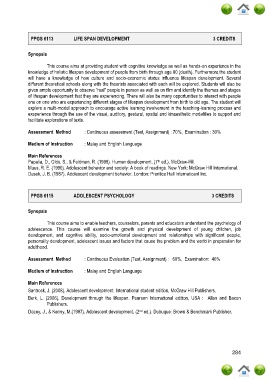Page 331 - Handbook Postgraduate (Master) 2015 2016 English
P. 331
PPGS 6113 LIFE SPAN DEVELOPMENT 3 CREDITS
Synopsis
This course aims at providing student with cognitive knowledge as well as hands-on experience in the
knowledge of holistic lifespan development of people from birth through age 80 (death). Furthermore,the student
will have a knowledge of how culture and socio-economic status influence lifespan development. Several
different theoretical schools along with the theorists associated with each will be explored. Students will also be
given ample opportunity to observe “real” people in person as well as on film and identify the themes and stages
of lifespan development that they are experiencing. There will also be many opportunities to interact with people
one on one who are experiencing different stages of lifespan development from birth to old age. The student will
explore a multi-model approach to encourage active learning involvement in the teaching-learning process and
exsperience through the use of the visual, auditory, gestural, spatial and kinaesthetic modalities to support and
facilitate explorations of texts.
Assessment Method : Continuous assessment (Test, Assignment) : 70%, Examination : 30%
Medium of Instruction : Malay and English Language
Main References
Papalia, D., Olds, S., & Feldman, R. (1998). Human development, (7 ed.). McGraw-Hill.
th
Muus, R. E. (1990). Adolescent behavior and society: A book of readings. New York: McGraw Hill International.
Dusek, J. B. (1987). Adolescent development behavior. London: Prentice Hall Internatioanl Inc.
PPGS 6115 ADOLESCENT PSYCHOLOGY 3 CREDITS
Synopsis
This course aims to enable teachers, counselors, parents and educators understand the psychology of
adolescence. This course will examine the growth and physical development of young children, job
development, and cognitive ability, socio-emotional development and relationships with significant people,
personality development, adolescent issues and factors that cause the problem and the world in preparation for
adulthood.
Assessment Method : Continuous Evaluation (Test, Assignment) : 60%, Examination: 40%
Medium of Instruction : Malay and English Language
Main References
Santrock, J. (2008). Adolescent development. International student edition, McGraw Hill Publishers.
Berk, L. (2006). Development through the lifespan. Pearson International edition, USA : Allan and Bacon
Publishers.
nd
Dacey, J., & Kenny, M.(1997). Adolescent development, (2 ed.). Dubuque: Brown & Benchmark Publisher.
284

